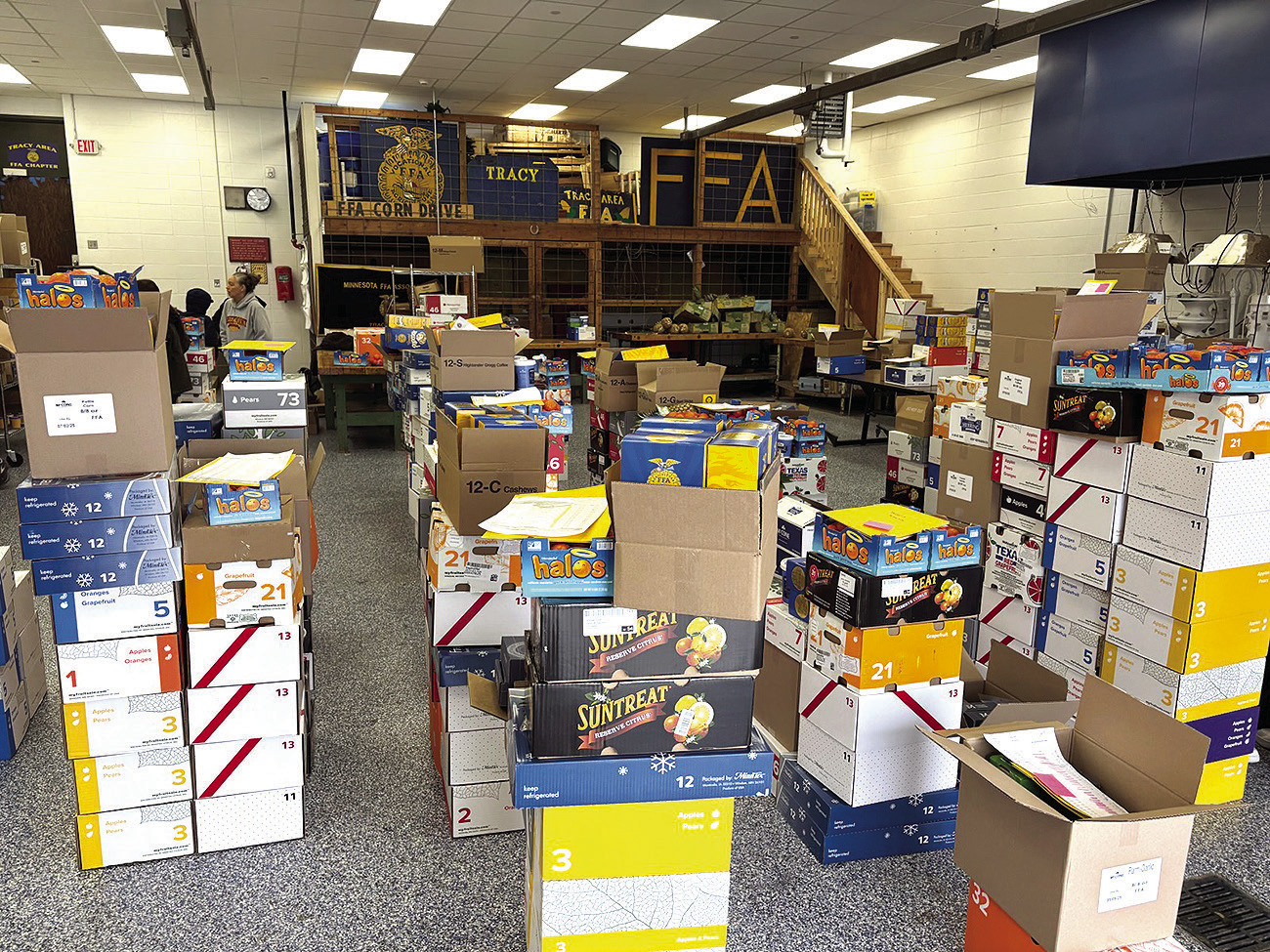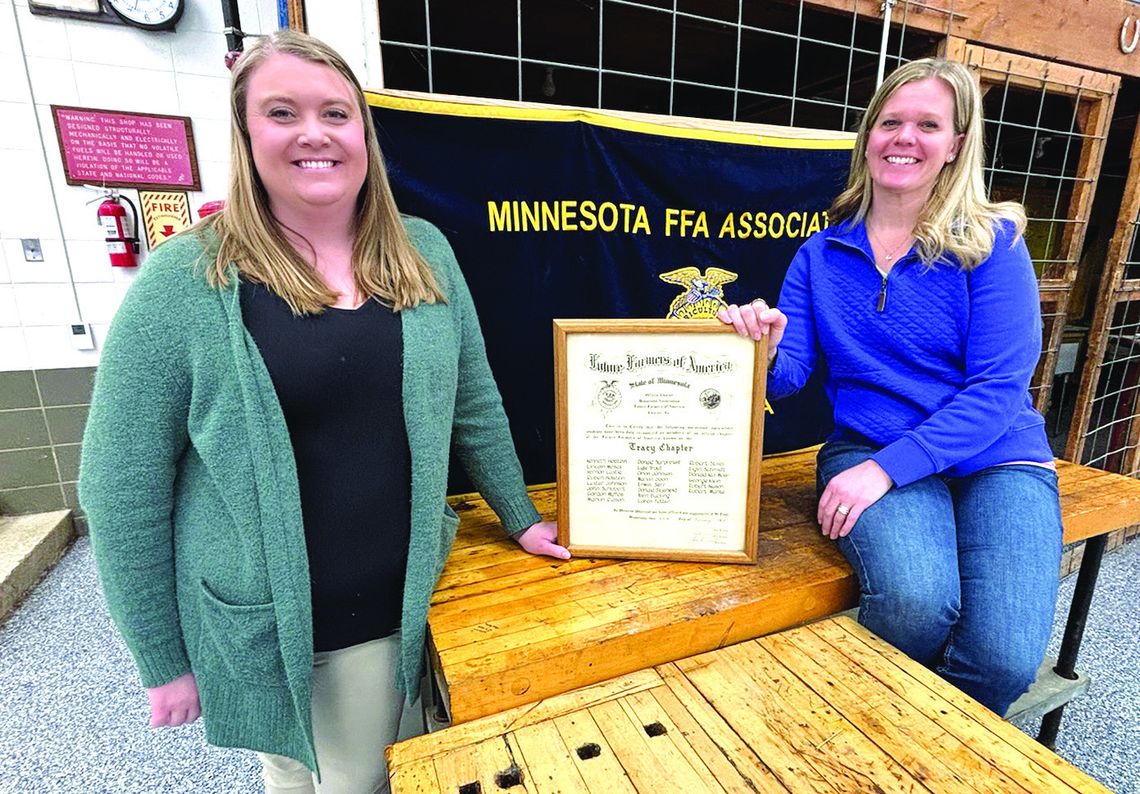FFA
The evolution of
Tracy Area High School’s program has come a long way since it started almost 90 years ago
The year was 1939. The German invasion of Poland signaled the start of World War II. The Great Depression ended.
Albert Einstein and President Roosevelt begin the Manhattan Project.
The novel The Grapes of Wrath was published. And Tracy High School’s chapter of Future Farmers of America — now known simply as FFA — held its first meeting, 11 years after the organization took hold in the United States as a way to keep older students from dropping out of school to help on the farm.
Thirty years later, girls were allowed to join the group.
By definition, the organization was originally established all those years ago by members of the farming community in support of agriculture education and it has seen many changes since those halcyon years. Just like combines have gotten bigger and more powerful over the decades, the THS FFA program has grown by leaps and bounds.
What started in Tracy as a collection of 22 youth has blossomed into a game-changing organization that now includes more than 90 boys and girls who this year have taken part in at least one event or who will participate in a Career Development Event (CDE).
There are twice as many members who have qualified for this year’s State Convention (57) then there were members 86 years ago.
“Back then, it was only farm boys,” said FFA coach and former TAHS FFAer John Lanoue. “It’s really evolved.”
Evolved to the point where today, the main advisor and the assistant advisor — Elizabeth Rupp and Jenna Buyck, respectively — are female.
High school ag teachers follow a three-circle model — one-third classroom, onethird Supervised Agricultural Experience, and one-third FFA experience.
“They’re the best,” Lanoue said of Rupp and Lanoue. “When I was teaching (ag), I would say there was a dozen female teachers and it’s completely flipped in the last 20 years.”
“I enjoy hanging out with the kids, teaching them and interacting with them,” Buyck said. “I was in FFA in high school and was our chapter president in South Dakota. “I like seeing the kids find their passion and niche. Seeing the Livestock team place first at regionals the other week was awesome. We have good coaches, good support in the community. It’s great to be part of something that keeps growing.”
Currently, four of the 10 CDE coaches are women: Buyck (Dairy), Nicole Hippe (Nursery Landscape), Tonya Duscher (FBM) and Kayla Daniels (Horse). They join Paul Skoglund (Soils), Lanoue (Poultry), Jeff Knott (Livestock), Karson Herfurth (Crops) and Ryan Paulsen (Fish and Wildlife).
“When they do workshops for future teachers, there will be, say, 60 future ag teachers that are a junior or senior in college and I would say not even 10% are boys,” said Rupp.
“The program is in good hands,” Skoglund said. “Elizabeth’s been doing a great job at the high school. It was strong when I came with Jere Rambow and Ken Schiller, who ended up going into ag banking.”
Rupp and Buyck aren’t the first female advisors at TAHS, but under their leadership, the stock on TAHS’s FFA Chapter has continued to rise. Not only are the numbers continuing to trend upwards, the success of those students has, too. The transition toward female involvement began during and after the Skoglund era. Skoglund taught ag at TAHS and ran the FFA program for 30 years, succeeding Jere Rambow in January 1988.
“There was a time when a student couldn’t take ag or be in FFA because they were a female, or they couldn’t take the home-ec classes because they were male,” Skoglund said. “Or they couldn’t take an ag class because they lived in town. Education in general, there were a few more barriers or judgements made, where now it’s certainly more balanced numerically male to female.” There were 27 proficiency applications in 2024 from TAHS students, 13 of which placed first at regions, seven second and six third — each of those advanced to State. There were also eight state degrees earned and one Star Agriscience finalist.
“The numbers continue to get bigger and bigger each year,” said Rupp.
The local 3-Star chapter is currently ranked the sixth best in the state, and 29 students attended the National Convention, with six earning American Degrees. Currently, a record 57 members have qualified for the State Convention, and “we don’t bring kids who have no reason to go,” Ruppert said. “The kids know that they have to work hard throughout the year in order to qualify.”
The chapter, selected as the Middle School/High School Outstanding Program for Region 6, put in more than 2,130 hours of community service this last year as well.
An even more significant change in the FFA program was the transition from only “farm boys” to a more allinclusive organization that now includes “city kids,” who don’t have that farming background.
“Trevor Humphrey is my example — he was a classmate of mine and never saw a chicken in his life, and he joined the Poultry team with me,” Lanoue said. “He just soaked it in, and now he’s an electrician. He tied it back into vocational work through the ag program. He lived on the lake with no connection to ag. Now he owns his own business.”
Skoglund said there is a very large number of ‘non-ag kids’ taking ag classes and participating in FFA today compared to years ago. When he came to Tracy in 1988, he said there were only a handful of girls in ag and FFA.
“It has changed, and our culture has changed, too,” he said. “That’s not just here, but on a national level as well. You can see it in leadership positions and awards being given out, which are much more proportionally represented.”
The blend of farm and city kids goes hand-in-hand with the evolution of FFA contests, Buyck said.
“There wasn’t Floriculutre way back when, and now there are ladies who like the Floriculture,” she said. “Now there are those kids who don’t have that tie to agriculture that are coming into these contests that weren’t available before.”
“I teach quite a bit of welding, we have AutoCad and 3D Printing, those were never offered until the last couple years,” Rupp said.
There also continues to be a direct correlation between parent and child. The four students who make up the Wildlife and Fisheries team, Buyck said, are children of the Returning Our Youth Outdoors (ROYO) members.
“They’re all ROYO kids,” Buyck said. “These are kids who are interested in hunting and fishing and are now in FFA. They don’t have farming backgrounds, but that interest in the community shifts over to that CDE event.”
Even with those two aspects resulting in more FFA kids, there still is somewhat of a recruiting process that takes place that supplements the traditional farm kids.
“For our Small Animal group, we recruited kids who like animals; they don’t have a farm background, and we’re like, ‘Well, let’s get these girls together and see if they’re interested,” Buyck said. “So we had a Small Animals team this year.”
Students are required to take at least one ag class per year in school to be in FFA, which essentially integrates FFA into the school curriculum. An online class worth a one-quarter credit is offered, as is a summer class.
Rupp said she teaches 182 kids throughout the year, and 95 of them have taken part in at least one FFA event, “whether that’s community service, or a judging contest,” said Rupp.
The local FFA chapter has also seen a rise in the number of younger kids — seventhand eighth-graders — which bodes well for the future.
“Seventh- eighth- and ninth-graders would sell the most fruit for us,” Lanoue said. “Young kids were champin’ at the bit to get involved in something; you’d think it would be the opposite.”
“Snag ‘em early,” added Buyck.
“Then there are some years where a senior decides to be active (in FFA) and say, ‘I should’ve done this sooner,’” Rupp added.
Even after his 30 years of leading the FFA charge at TAHS, Skoglund is proud to have remained involved in the program as a coach. He said part of the reason why he has continued with FFA after retirement is his competitive nature. Mostly, however, the former teacher and coach enjoys seeing the kids succeed.
“I like to see youth succeed; learning and success build on each other,” he said. “It’s about the work, the learning, the self discipline. Hopefully they apply that to other parts of their life when they get older. I hope (FFA) is a positive experience for them. I love high school sports, but we don’t have any kids make a living from it, so why do they do things like athletics or FFA? There’s skills and attitudes that they can take with them later in life.”
Skoglund said farming is still at the heart of FFA, and it’s important for youth to understand the impact it has on society, whether they’re from the farm or live in the city. From a small-scale perspective, many business in town are impacted by agriculture, to a national scope where ag products are the nation’s largest exports.
“I used to tell kids, ‘If you eat, you have an interest in agriculture,” he said. “The first word that people think of is farming, which certainly is the core … if you just look around our town, if you work at John Deere you have an interest and need to know something about agriculture. Probably our biggest employer might be the elevator — it reaches out and touches everyone, especially in a rural area.”
He added that the agriculture field offers a large number of opportunities for students and having an FFA experiences to fall back on could potentially help them after high school and/or college.
“You’ve got this small town, what’s the root of our small town — whether it’s 20 people or 2,000 people — we’re rooted in agriculture,” Lanoue said. “I told my kids, if they wanted to come back to the area, that’s kind of the path. And it can be a million things. There are all sorts of things that branch out from agriculture, whether it’s becoming a florist, an ag teacher, or an ag journalist, or in agronomy.”
Aside from competing against other FFA students and all that comes with it, local FFA students also do plenty of fundraising. This past year, they raised more than $47,000 in the annual Fruit Drive, and $6,750 was raised in the strawberry sale. There is fundraising through the FFA corn plot, too, as well as vending machine sales. They also raise money for Camp Courage through the annual Corn Drive. They also donate fleece blankets to the Tracy Lions’ “Help Tuck Them In” program and to the Children’s Hospital in Sioux Falls.
“It’s huge,” said Rupp of fundraising. “Typically when we go to a regional contest, kids have to pay for their own lunch, but when it comes to State Convention when we bring 57 kids, we’re charging 50 bucks a kid, but the total cost is just over $200 per kid. At state, there’s hotels, transportation, we usually feed them, so we’re looking at $10,000-$11,000 and kids only have to pay 50 bucks because of fundraising. I want kids to participate and not have money be the issue why they’re not participating.”
‘
There was a time when a student couldn’t take ag or be in FFA because they were a female, or they couldn’t take the home-ec classes because they were male. Or they couldn’t take an ag class because they lived in town.
Education in general, there were a few more barriers or judgement made, where now it’s certainly more balanced numerically male to female.
— FFA SOILS COACH PAUL SKOGLUND







